
Ïî÷òîâûå ìàðêè ñòðàí Þæíîé Àìåðèêè
Postage stamps of South African countries
Briefmarken Sudafrikan
Francobolli dei paesi dell`Africa del Sud
 COMORES (COMOROS)
COMORES (COMOROS)
 1979 Rep. Fed. Islamique des Comores (1978-1992)
1979 Rep. Fed. Islamique des Comores (1978-1992)


 1981 Rep. Fed. Islamique des Comores (1978-1992)
1981 Rep. Fed. Islamique des Comores (1978-1992)



 1984 Republique Federale Islamique des Comores (1978-1992)
1984 Republique Federale Islamique des Comores (1978-1992)



 1984 République Fédérale Islamique des Comores (1978-1992)
1984 République Fédérale Islamique des Comores (1978-1992)
Mercedes (1903)



 1988 République Fédérale Islamique des Comores (1978-1992)
1988 République Fédérale Islamique des Comores (1978-1992)
Rudolf Diesel

 2008 Union des Comores
2008 Union des Comores
Simplex


 2008 Union des Comores
2008 Union des Comores
300SL
Daimler Maybach


 2008 Union des Comores
2008 Union des Comores
Benz


 2008 Union des Comores
2008 Union des Comores
ambulance truck



 2008 Union des Comores
2008 Union des Comores
Voiture postale espagnole (Correos): Mercedes-Benz truck

 2008 Union des Comores
2008 Union des Comores
Evolution automobile

 2009 Union des Comores
2009 Union des Comores
Rudolf Diesel

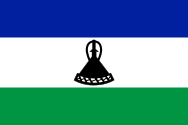 LESOTHO
LESOTHO
 1985 Lesotho
1985 Lesotho
Mercedes-Benz 500SE



 2000 Lesotho
2000 Lesotho
The First Cars

 2000 Lesotho
2000 Lesotho
The First Cars

 MADAGASCAR
MADAGASCAR
 1977 Repoblika Demokratika Malagasy (Democratic Republic of Madagascar, 1975-1992)
1977 Repoblika Demokratika Malagasy (Democratic Republic of Madagascar, 1975-1992)

 1984 Repoblika Demokratika Malagasy (Democratic Republic of Madagascar, 1975-1992)
1984 Repoblika Demokratika Malagasy (Democratic Republic of Madagascar, 1975-1992)

 1984 Repoblika Demokratika Malagasy (Democratic Republic of Madagascar, 1975-1992)
1984 Repoblika Demokratika Malagasy (Democratic Republic of Madagascar, 1975-1992)


 1988 Repoblika Demokratika Malagasy (Democratic Republic of Madagascar, 1975-1992)
1988 Repoblika Demokratika Malagasy (Democratic Republic of Madagascar, 1975-1992)
Blitzen Benz (1909), 210 kmh


 1988 Repoblika Demokratika Malagasy (Democratic Republic of Madagascar, 1975-1992)
1988 Repoblika Demokratika Malagasy (Democratic Republic of Madagascar, 1975-1992)




 1990 Repoblika Demokratika Malagasy (Democratic Republic of Madagascar, 1975-1992)
1990 Repoblika Demokratika Malagasy (Democratic Republic of Madagascar, 1975-1992)



 1992 Repoblika Demokratika Malagasy (Democratic Republic of Madagascar, 1975-1992)
1992 Repoblika Demokratika Malagasy (Democratic Republic of Madagascar, 1975-1992)



 1996 Repoblikan'i Madagasikara
1996 Repoblikan'i Madagasikara

 1998 Repoblikan'i Madagasikara
1998 Repoblikan'i Madagasikara
Mercedes SLK Brabus


 2020 Repoblikan'i Madagasikara
2020 Repoblikan'i Madagasikara
Mercedes-Benz: 540K, 630K cabriolet (1927), 630K (1929), 770 (W07) (1930), 320B (1937), 320 cabriolet (1940)
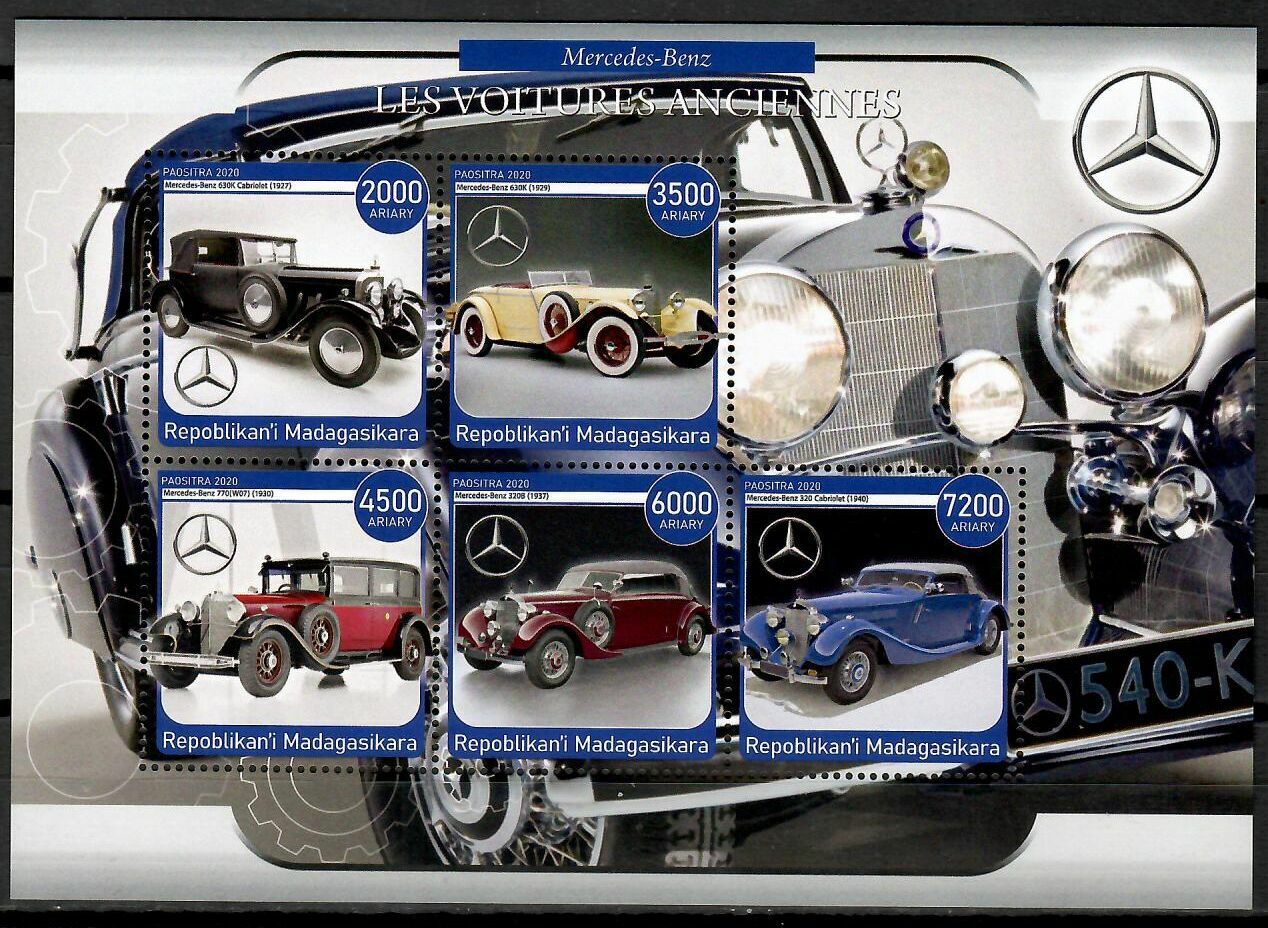
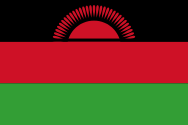 MALAWI
MALAWI
 2006 Malawi
2006 Malawi

 2008 Malawi
2008 Malawi
Daimler, Mercedes

 2008 Malawi
2008 Malawi
Karl Benz



 2008 Malawi
2008 Malawi
Gottlieb Daimler



 2010 Malawi
2010 Malawi


 2010 Malawi
2010 Malawi
300 SL


 2012 Malawi
2012 Malawi
Top Formula 1 drivers of all times: Juan Manuel Fangio


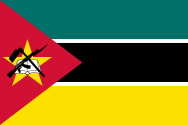 MOZAMBIQUE
MOZAMBIQUE
 2000 Moçambique
2000 Moçambique
Fangio

 2002 Moçambique
2002 Moçambique
Mercedes (1906)


 2002 Moçambique
2002 Moçambique
Mercedes-Benz SSK (1928)


 2002 Moçambique-Correios
2002 Moçambique-Correios
Mercedes racing car, Juan Manuel Fangio

 2009 Moçambique
2009 Moçambique
Mercedes-Benz 300SL


 2009 Moçambique
2009 Moçambique
Mercedes-Benz trucks firefighters


 2009 Moçambique
2009 Moçambique
Mercedes Unimog firefighter

 2011 Moçambique
2011 Moçambique
100o Aniversario de Juan Manuel Fangio (1911-1995)


 2013 Moçambique
2013 Moçambique
Mercedes-Benz Papamobil ML 430


 2013 Moçambique
2013 Moçambique
Mercedes racing car

 2015 Moçambique
2015 Moçambique
Carros lendarios



 2016 Moçambique
2016 Moçambique
Transportes especiais: Mercedes-Benz Sprinter CDI ambulance

 2016 Moçambique
2016 Moçambique
Grande incendio de Londres: Mercedes fire truck

 2021 Moçambique
2021 Moçambique
Carros dos bombeiros: Mercedes 1529 fire truck
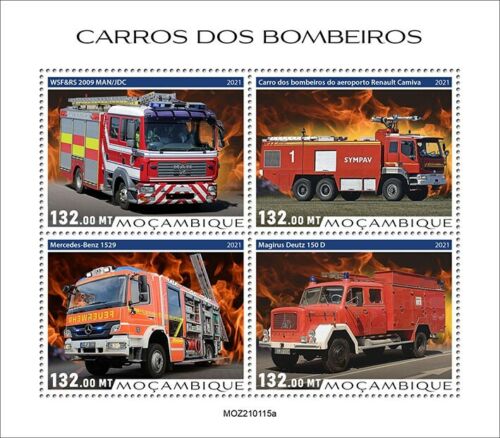
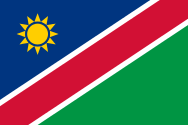 NAMIBIA
NAMIBIA
 2009 Namibia
2009 Namibia
Benz (Motor Werke Gaggenau)
The first crossing of Africa by car was successfully completed on May 1, 1909 when Paul Graetz arrived in Swakopmund in today's Namibia, formerly German South West Africa, in his special vehicle produced by Süddeutsche Automobilfabrik Gaggenau GmbH, a company that became Benz-Werke Gaggenau at a later stage. Graetz' outstanding achievement is exemplified particularly well by a single figure: An average of just 15 kilometers was covered per day, testifying to the trials and tribulations of the journey over 9,500 kilometers and completed in 630 days. Graetz set out on this journey on August 10, 1907 in Dar es Salaam in today's Tanzania, formerly German East Africa. Graetz had planned to cross Africa in twelve months but the crossing actually took him one year and ten months. During his journey, he came up against everything a continent like Africa had – and still has – in store in the way of adverse conditions. Even in an offroader equipped with the latest engineering, such a trip would still be an adventure today.
Graetz' accomplished his feat not least because of the reliability of his vehicle. The special vehicle produced to Graetz' specifications had been built by Süddeutsche Automobilfabrik Gaggenau and completed with a special body by Berlin-based bodybuilder Neuss. The bus chassis had particularly large wheels in format 1120/120 and wooden blocks under the leaf springs to raise ground clearance: the vehicle's lowest point was 35 centimeters above the ground. In his book "Im Auto quer durch Afrika" ('Across Africa by Car') published in 1910, Graetz described the vehicle as follows: "The bodywork has an American soft-top, and by folding down the backrests of the front seats, two comfortable beds can be created." As was customary at the time, the steering wheel was on the right-hand side. The modern four-cylinder engine with magneto ignition and water cooling developed 35 hp and drove the rear axle via chains; the transmission gearwheels were interchangeable to enable the vehicle to climb steep hills. A 250 liter gasoline tank was mounted under the rear seats, and a second tank with a capacity of 145 liters was fitted at the front. A sheet-metal drum for provisions was accommodated in the recess provided by the four spare wheels at the rear of the vehicle.
Paul Graetz, a first lieutenant of the East African protective forces, had been born in Reichenau near Zittau/Saxony, on July 24, 1875. He was convinced of the capabilities of the automobile and endeavored to prove with his undertaking that motor vehicles were able to cope with long and difficult routes, and that they were suitable for carrying loads in the hinterland of the black continent – loads which were carried on camel back, on ox-drawn carts and on the locals’ heads at the time. As his plans to cross Africa from east to west matured, he was unable to solicit support – nobody believed that he would be able to do it. Finally, Graetz had to invest his own funds in his undertaking. He had estimated a total cost of 75,000 gold marks. The automobile alone cost him 13,000 gold marks; the trip itself was to devour twice the estimated amount.
Graetz had the vehicle built during a vacation in Germany in 1904. However, another three years passed before it arrived in Dar es Salaam on the steamer "Feldmarschall". Graetz had been granted leave from army service for his undertaking which had to be planned with high precision. There were hardly any roads, so he had to use trails or caravan routes – the latter with no more than camel width, however. Planning the individual stages proved to be the clearly more cumbersome part of the preparations because it was a question of ensuring supplies with fuel and foodstuffs along the route. The adventurer specified the locations for 24 depots and commissioned companies, missions and farmers to bury gasoline barrels, oil cans, tires, tubes and other replacement parts at these locations. He had an unconventional but effective and clear way of marking the depots to identify them and prevent theft, namely by means of simple crosses with the name "Graetz" on them. He had a total of 6,000 liters of gasoline, over 200 liters of oil, 25 rubber tires and 33 tubes deposited – and he did find most of his supplies on the journey, something that bordered on a miracle in view of the duration of the crossing.
On August 3, 1907, Graetz arrived in Dar es Salaam together with his travel companion Theodor von Roeder and driver Neuberger, a mechanic trained at the factory in Gaggenau. The wooden crate containing the automobile and weighing two-and-a-half tons was carefully lowered onto the quay. The vehicle was unpacked and service fluids were filled in. A turn of the starter crank and the engine came to life, providing the confidence that the undertaking was to succeed in technical terms. It goes without saying that the car caused quite a sensation because motor vehicles were few and far between in Africa in those days. What's more, the vehicle looked most impressive on its large wheels. Graetz additionally hired a local cook, Mtsee, to cater for the small team of adventurers. Right from the start, they had planned not just to live on canned food but also to shoot game to obtain fresh meat. The rifles were also to come in useful in warding off predators.
On the first trips through Dar es Salaam, the team realized that the vehicle was much too heavy. Luggage and provisions were reduced to the absolute essential, fenders and exhaust system were removed. From then on, the engine roared sonorously and earned Graetz a nickname: the Africans called him "Bwana Tucke Tucke", which freely translates into 'Master of the Motor Vehicle'.
Finally, everything was ready and the team set off at 5.20 p.m. on August 10. Graetz described his departure in his book: "The sun was already low in the slightly overcast sky when the telegrams reporting on the start had been sent off to Europe from the post office of Dar es Salaam and the vehicle set off, accompanied by the cheers of a large crowd, down the acacia-lined avenue in the direction of Pugu, our first day's destination 20 kilometers away. A winding sand track up a 20 percent incline was the first opportunity for the engine to pass its first test with flying colors."
During the following months, the team rarely progressed as speedily, however, quite on the contrary. The tracks were simply not made for vehicles; they were narrow, bumpy and full of obstacles which were no problem for humans or animals but made a motor vehicle look like an immobile monster. Graetz' idea of giving the vehicle large wheels for generous ground clearance proved to have been a minimum of foresight. In spite of this, the vehicle had to be pushed or towed over long distances time and again, often with the help of the locals. Greater obstacles called for greater efforts: to prevent the vehicle from sinking into swamps, kilometer-long log roads had to be built. There were no ferries across rivers and no bridges across gorges big or strong enough to support the vehicle, and there were slopes too steep for the vehicle to climb; hence the vehicle had to be dismantled – 32 times altogether – and carried across obstacles in individual parts, and every time, the adventurers had to recruit the help of local people. As many as 28 provisional bridges were built – time-consuming undertakings in each case. The longest stopover was caused when the vehicle stranded right in the middle of a river: two of the four hot cylinders burst when they came into contact with the cold water. Driver Neuberger traveled back to Germany to fetch replacement cylinders. The journey's trials and tribulations had apparently been too much for him: after three months, another mechanic returned from the factory in Gaggenau, and the journey was continued. In the course of the crossing, Graetz was to "wear out" as many as four drivers who also had to tend to the vehicle's mechanical problems time and again. The engineering may have been robust but under the harsh conditions in Africa, quite a few defects occurred which, in the absence of the required replacement parts, had to be repaired with improvising talent and ingenuity. However, this did not deter the team; minor mishaps were part and parcel of the drivers' lives in the early years of the automobile.
Driving on the dam of a newly built railway line was equally adventurous; not only did the sleepers provide for a bumpy ride but, needless to say, the adventurers also encountered one of the rare trains at the time. The driver was able to steer the vehicle into the bushes just in time. Climatic conditions also made life difficult for Graetz and his companions. They suffered under the high temperatures and humidity, were caught in sandstorms and tormented by thirst. Malaria attacks time and again forced them to rest. But the journey also had its rewarding moments. Near the Victoria Falls, Graetz was the first to cross the railway bridge across the Zambezi river in a motor vehicle, and the officer noted in the permit: "First motor car to cross Zambezi River Bridge."
Eventually, the team ran out of money. The undertaking was extremely expensive. But Graetz once gain proved his ingenuity. He had taken a large number of photographs on the journey, so he had them developed and went on a tour of German colonial towns where he reported about his crossing of Africa. The money he earned with his lectures allowed him to continue the journey.
They celebrated Christmas 1908 in Johannesburg, the southernmost point of their journey. From then on, they progressed towards German South West Africa relatively speedily, but there was still an enormous obstacle to be overcome: the Kalahari desert. They started crossing the desert on January 10, 1909 with 800 liters on gasoline and 100 liters of oil on board. Once again, however, the adventurers were tormented by the elements in their worst form: sand, heat and water in all their variations hit them hard. But they did make it. On March 13, Graetz made out the tower of the police station of Rietfontein with its black, white and red flags in the distance. They had finally arrived in German South West Africa. It took the team another four weeks, however, to reach the capital, Windhoek, because the rainy season had meanwhile begun, turning rivers into insurmountable obstacles. Graetz arrived in Windhoek on April 6. But despite the great, cordial reception he was given, he didn't stay long in the town but was eager to continue his journey to his final destination. He set out again on April 25, 1909 and successfully crossed the Namib desert. On May 1, he arrived in Swakopmund and the coast of the Atlantic: he had made it – he had crossed the African continent! Both the team and the vehicle showed the signs of the strains to which they had been subjected – the daily mileage of 15 kilometers mentioned earlier clearly testifying to the trials and tribulations. Nevertheless, Graetz was happy. He had proved that Africa's hinterland could be mastered by car and that the motor vehicle was able to withstand the enormous stresses. Even before he got round to sending a telegram with the good news to Germany, he received a telegram himself, from the German Emperor: "Well done, by dear Graetz. Wilhelm I. R." The British King Edward VII. also sent his congratulations.
After 9,500 eventful kilometers, the vehicle looked the worse for wear but was still fully operational, as Emperor Wilhelm was able to find out for himself when Graetz returned to Hamburg. It is however not known what happened to the vehicle afterwards.
On this trip, Graetz had caught the adventure bug once and for all. He retired from the army, and two years after his successful crossing of Africa by car, he was the first to cross the black continent by motorboat, from the mouth of the Zambezi to the mouth of the Congo – a journey that took him twelve months. His plan to cross New Guinea was thwarted by the outbreak of World War I. During the war, Graetz served as a fighter pilot on the western front. After the war, he was involved in building up a company that was to become Lufthansa at a later stage. He died in Travemünde in the north of Germany in February 1968, having spent the last years of his life in a house named "Afrikaruh" ('African Rest') on the coast of the Baltic Sea.
(Der deutsche Indiana Jones ist auf dem Mond angekommen - Hinter dieser etwas seltsam anmutenden Überschrift verbirgt sich eine wahre Begebenheit.
Der Deutsche Paul Graetz, ein Abenteurer und deshalb Indiana Jones seiner Zeit, wollte im Jahre 1907 als erster Mensch den afrikanischen Kontinent mit dem Automobil durchqueren. Eine Berliner Zeitung hielt dieses Unternehmen für undurchführbar und schrieb, es würde auf dasselbe herauskommen, als wolle er eine Reise zum Mond unternehmen. Das Fahrzeug, eigentlich der erste Geländewagen der Welt, stammte von den Motoren-Werken Gaggenau – dem Werk, das später von Benz übernommen wurde und in dem heute die geländegängigen Unimogs produziert werden. Das Abenteuer gelang – und nach vielen Schwierigkeiten und Problemen erreichte Paul Graetz am 1. Mai 1909 nach 630 Tagen sein Ziel in Swakopmund, dem damaligen Deutsch-Südwestafrika.
„Bin auf dem Mond angekommen“, schrieb darauf Paul Graetz auf eine Postkarte an die Berliner Zeitung.)

 SOUTH AFRICA
SOUTH AFRICA
 VENḒA
VENḒA
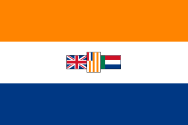 1986 South Africa (1928-1994)
1986 South Africa (1928-1994)
Mercedes-Benz 220 (1958)




 1986 Venḓa (1979-1994)
1986 Venḓa (1979-1994)
1958 cabriolet
First day cover




 1997 RSA
1997 RSA
1897 Benz




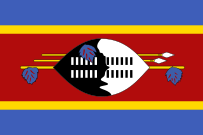 SWAZILAND
SWAZILAND
 2016 Swaziland
2016 Swaziland
Carl Friedrich Benz, Mercedes-Benz 170 (1950)
Gottlieb Daimler, Mercedes-Benz 540K (1934)


 ZAMBIA
ZAMBIA
 1987 Zambia
1987 Zambia
Leaders of the world FDC: W111
Mercedes SSK: 22k gold stamp


 1998 Zambia
1998 Zambia


 1998 Zambia
1998 Zambia
Mercedes-Benz 280SE


 ZIMBABWE
ZIMBABWE
 1986 Zimbabwe
1986 Zimbabwe



 1986 Zimbabwe
1986 Zimbabwe
FDC

 TRISTAN DA CUNHA
TRISTAN DA CUNHA
 2007 Tristan da Cunha
2007 Tristan da Cunha

 COMORES (COMOROS)
COMORES (COMOROS)
 COMORES (COMOROS)
COMORES (COMOROS) 1979 Rep. Fed. Islamique des Comores (1978-1992)
1979 Rep. Fed. Islamique des Comores (1978-1992) 1981 Rep. Fed. Islamique des Comores (1978-1992)
1981 Rep. Fed. Islamique des Comores (1978-1992) 1984 Republique Federale Islamique des Comores (1978-1992)
1984 Republique Federale Islamique des Comores (1978-1992) 1984 République Fédérale Islamique des Comores (1978-1992)
1984 République Fédérale Islamique des Comores (1978-1992) 1988 République Fédérale Islamique des Comores (1978-1992)
1988 République Fédérale Islamique des Comores (1978-1992) 2008 Union des Comores
2008 Union des Comores 2008 Union des Comores
2008 Union des Comores 2008 Union des Comores
2008 Union des Comores 2008 Union des Comores
2008 Union des Comores 2008 Union des Comores
2008 Union des Comores 2008 Union des Comores
2008 Union des Comores 2009 Union des Comores
2009 Union des Comores LESOTHO
LESOTHO  1985 Lesotho
1985 Lesotho 2000 Lesotho
2000 Lesotho 2000 Lesotho
2000 Lesotho MADAGASCAR
MADAGASCAR  1977 Repoblika Demokratika Malagasy (Democratic Republic of Madagascar, 1975-1992)
1977 Repoblika Demokratika Malagasy (Democratic Republic of Madagascar, 1975-1992) 1984 Repoblika Demokratika Malagasy (Democratic Republic of Madagascar, 1975-1992)
1984 Repoblika Demokratika Malagasy (Democratic Republic of Madagascar, 1975-1992) 1984 Repoblika Demokratika Malagasy (Democratic Republic of Madagascar, 1975-1992)
1984 Repoblika Demokratika Malagasy (Democratic Republic of Madagascar, 1975-1992) 1988 Repoblika Demokratika Malagasy (Democratic Republic of Madagascar, 1975-1992)
1988 Repoblika Demokratika Malagasy (Democratic Republic of Madagascar, 1975-1992) 1988 Repoblika Demokratika Malagasy (Democratic Republic of Madagascar, 1975-1992)
1988 Repoblika Demokratika Malagasy (Democratic Republic of Madagascar, 1975-1992) 1990 Repoblika Demokratika Malagasy (Democratic Republic of Madagascar, 1975-1992)
1990 Repoblika Demokratika Malagasy (Democratic Republic of Madagascar, 1975-1992) 1992 Repoblika Demokratika Malagasy (Democratic Republic of Madagascar, 1975-1992)
1992 Repoblika Demokratika Malagasy (Democratic Republic of Madagascar, 1975-1992) 1996 Repoblikan'i Madagasikara
1996 Repoblikan'i Madagasikara  1998 Repoblikan'i Madagasikara
1998 Repoblikan'i Madagasikara  2020 Repoblikan'i Madagasikara
2020 Repoblikan'i Madagasikara  MALAWI
MALAWI  2006 Malawi
2006 Malawi 2008 Malawi
2008 Malawi 2008 Malawi
2008 Malawi 2008 Malawi
2008 Malawi 2010 Malawi
2010 Malawi 2010 Malawi
2010 Malawi 2012 Malawi
2012 Malawi MOZAMBIQUE
MOZAMBIQUE  2000 Moçambique
2000 Moçambique 2002 Moçambique
2002 Moçambique 2002 Moçambique
2002 Moçambique 2002 Moçambique-Correios
2002 Moçambique-Correios 2009 Moçambique
2009 Moçambique 2009 Moçambique
2009 Moçambique 2009 Moçambique
2009 Moçambique 2011 Moçambique
2011 Moçambique 2013 Moçambique
2013 Moçambique 2013 Moçambique
2013 Moçambique 2015 Moçambique
2015 Moçambique 2016 Moçambique
2016 Moçambique 2016 Moçambique
2016 Moçambique 2021 Moçambique
2021 Moçambique NAMIBIA
NAMIBIA  2009 Namibia
2009 Namibia  SOUTH AFRICA
SOUTH AFRICA  VENḒA
VENḒA  1986 South Africa (1928-1994)
1986 South Africa (1928-1994) 1986 Venḓa (1979-1994)
1986 Venḓa (1979-1994) 1997 RSA
1997 RSA SWAZILAND
SWAZILAND  2016 Swaziland
2016 Swaziland ZAMBIA
ZAMBIA  1987 Zambia
1987 Zambia 1998 Zambia
1998 Zambia 1998 Zambia
1998 Zambia ZIMBABWE
ZIMBABWE  1986 Zimbabwe
1986 Zimbabwe 1986 Zimbabwe
1986 Zimbabwe TRISTAN DA CUNHA
TRISTAN DA CUNHA  2007 Tristan da Cunha
2007 Tristan da Cunha